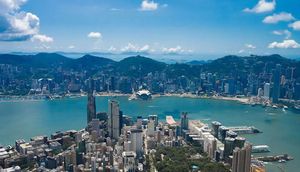Asia-Pacific Disaster Risk Reduction Investments are more pressing than ever, as highlighted during the recent Asia-Pacific Ministerial Conference on Disaster Risk Reduction held in Manila, Philippines. UN officials, led by Assistant Secretary-General Kamal Kishore, have emphasized the urgent need for nations within this vulnerable region to bolster their investment strategies aimed at mitigating the impact of increasingly powerful and frequent natural disasters.
"Disasters are now affecting record numbers of people and threatening their lives and livelihoods,” Kishore stated, addressing delegates made up of government ministers and disaster management experts from across the region. He warned if current trends continue unchecked, these risks could significantly derail economic progress—a sentiment echoed across various discussions at the conference.
The Philippines, positioned as one of the world’s most disaster-prone countries due to its geographical location, faces relentless threats from about 20 typhoons and storms each year and the constant risk of volcanic eruptions and earthquakes. President Ferdinand Marcos Jr. underscored this vulnerability, stating, "The increasing frequencies of hazards brought about by climate change make our landscapes even riskier.”
Indeed, the urgent call to action has never been more relevant, with the Asia-Pacific region being particularly susceptible to climate-related disasters. This has been compounded by the growing severity of these events—flooding, landslides, and other calamities not only threaten lives but hinder the socio-economic development of nations.
During his keynote speech, Marcos emphasized the importance of resilience and sustainability, arguing these must underpin economic agendas across the Asia-Pacific. "All our efforts in economic planning are fragile in the face of calamities and disasters," he remarked. This call to acknowledge the intertwined nature of economic growth and disaster preparedness reflects the overarching theme of this year's conference: "Surge to 2030: Enhancing ambition in Asia-Pacific to accelerate disaster risk reduction.”
Integral to this framework is the Sendai Framework for Disaster Risk Reduction, established on March 18, 2015, by UN member states. The framework aims to prevent new disaster risks, reduce existing ones, and encourage coordinated international efforts. Marcos urged all countries to double their investment and efforts aligned with this framework to build more secure communities and economies.
Kishore highlighted successful strategies from across the region, stressing the importance of innovative infrastructure and technology sharing to improve disaster resilience. "Such investments have brought down death tolls,” he remarked. Asia-Pacific countries have historically managed to reduce mortality rates during disasters, and sharing these effective strategies could be invaluable to those currently facing devastating calamities.
To facilitate this shared knowledge, discussions at the conference centered on enhanced disaster warning systems and the integration of advanced technologies for climate data. The urgent need for improved infrastructure, including resilient homes and workplaces, was emphatically addressed, showcasing the substantial benefits of adopting comprehensive disaster prevention strategies.
European Commissioner for Crisis Management Janez Lenarčić articulated the situation’s urgency, stating, "None of us will be able to face these new challenges alone.” He pointed out the role of international cooperation, urging wealthier nations to contribute more resources to disaster preparedness and mitigation efforts across the Asia-Pacific region. Since 2020, the European Union has invested over €80 million ($87 million) to finance disaster risk reduction initiatives, demonstrating the need for substantial financial backing from all countries impacted by climate change.
Recognizing this collaborative effort, Marcos called for enhanced engagements among various sectors, combining resources, knowledge-sharing, and coordinated action plans to prepare for and react effectively to natural disasters. The Philippines is already contributing to this global dialogue by co-hosting the Loss and Damage Fund Board, aimed at supporting vulnerable nations.
Beyond prevention strategies, there’s also burgeoning interest around financial investments aimed at achieving disaster resilience. The government’s guidelines on public issuance of green and blue bonds hint at innovative approaches to financing climate-adaptive projects. Green bonds, for example, are aimed at supporting renewable energy and climate resilience projects, which could potentially catalyze significant investments from the private sector.
Marcos also pointed to the need for creating and reinforcing international legal frameworks directing disaster prevention and response, emphasizing the interconnectedness of nations when confronting crises. "It’s not just about local issues; disasters don’t respect borders,” he articulated, reinforcing the universal need for enhanced legal structures to support collective responses to climatic threats.
The Asia-Pacific Ministerial Conference on Disaster Risk Reduction provided not just a platform for sharing such insights but also for reinforcing commitments at all levels—from community initiatives to government legislation. The desire to significantly scale up investments toward disaster risk reduction is not just prevalent but deemed imperative among participating countries.
Essentially, addressing climate-induced disasters is not merely about mitigating immediate hazards; it’s about reshaping national agendas to account for long-term sustainability and economic stability. Each nation must craft policies reflective of this reality—integrated approaches offering resilience against the unpredictable nature of climate change must be prioritized.
With greater investment, innovative ideas, and shared commitments, there’s hopeful optimism around advancing disaster risk reduction across the Asia-Pacific region. The way forward requires tapping collective wisdom, financial resources, and relentless determination to forge stronger, more resilient societies.
While the decisions taken during the APMCDRR will contribute to mitigating future crises, the real test of commitment will lie within the actions taken by individual nations post-conference. Time will tell if the call for substantial investments and improvements will translate to real-world benefits, safeguarding not only peoples’ lives but also their livelihoods against the ravaging forces of nature.



